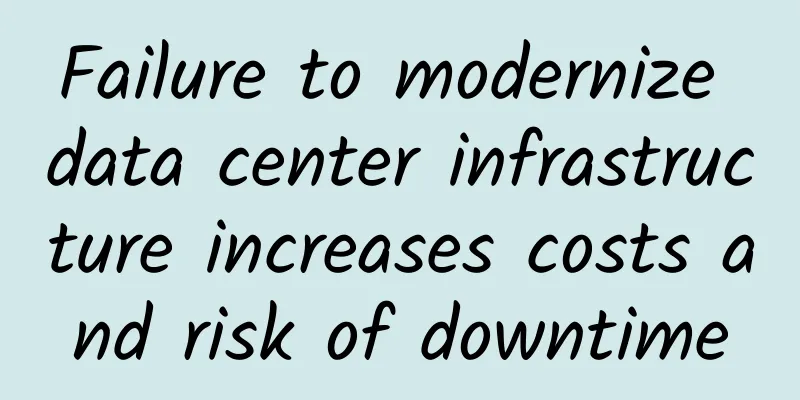Failure to modernize data center infrastructure increases costs and risk of downtime

|
Today's data centers are more dynamic than ever before, with constant changes often a reflection of market behavior as organizations strive to anticipate new customer needs. In the data center information technology (IT) world, innovations that improve performance often drive investments in data center modernization. As a result, it is not uncommon for servers to be refreshed or upgraded every three years, and servers are only part of a data center facility.
In the data center's operational technology (OT), traditional infrastructure (such as power, cooling and ventilation facilities) is updated much more slowly (for equipment such as UPS batteries and computer room air conditioners, the update time is usually 10 to 20 years). But now that the system design of operational technology (OT) has begun to be applied in built-in intelligent, digital components and network facilities, the long-term idleness of modern operational technology (OT) systems brings downtime risks and economic losses. In fact, outdated physical infrastructure sometimes hinders the expected benefits of IT technology updates. When people neglect to modernize the physical infrastructure of their data centers, the following problems arise: Increased operating costs New equipment in data center infrastructure is far more efficient than legacy equipment. As a result, legacy equipment is often synonymous with higher energy consumption. Take an uninterruptible power supply (UPS) as an example. When comparing a modern UPS (96% efficiency) with a legacy UPS with the same load characteristics (88% efficiency), the energy cost (additional energy costs due to inefficiency) of the legacy UPS is nearly $400,000 more over a 10-year operating period. In fact, some UPSs can reach 99% efficiency when running in eco-mode. The same is true for cooling facilities, which traditionally consume more electricity in data centers. New cooling systems consume less energy, thereby reducing CO2 emissions. Reduced system reliability When determining system reliability, it is important not to confuse the reliability of individual power components with the reliability of the power system. A power system is only as reliable as its weakest link. If a data center's infrastructure has not been modernized in eight to 12 years, there are still many weak links, and the question is not whether a failure will occur, but when it will occur. Legacy data center infrastructure equipment requires more time, effort, and expense to support. For example, as parts inventory decreases over time, spare parts will cost more. The mean time to repair (MTTR) of a data center will also increase as it becomes increasingly difficult to find the right technicians to repair legacy equipment. When it comes to cooling a data center, innovative cooling systems take up less floor space and are generally much simpler to access and maintain, which also reduces repair time. Limitations of data center flexibility In today's data centers, the term flexibility means the need to deploy data center assets in innovative ways to enable data center business to grow faster. Because the market is changing rapidly, data center operators also need to respond quickly. Traditional outdated physical infrastructure limits this flexibility, and installing advanced IT equipment in the original data center facilities limits the benefits of adopting new technologies. In some cases, new IT technologies overload the original infrastructure or even fail. If the existing UPS power supply cannot meet the current or future mission-critical performance requirements of the organization (such as the required redundancy and runtime levels to support the entire IT load), the UPS power supply is in an "end of life" state. Newer technologies such as modular, scalable infrastructure, mobile prefabricated infrastructure, etc. are key drivers for improving data center flexibility because they support rapid business expansion. Modern data center physical infrastructure systems now provide data operators with warning signs of system aging. For example, instead of discovering a problem when a UPS power system fails, new remote monitoring services provide data on the age and warranty of components such as AC capacitors, batteries, DC capacitors, fans, power supplies, contactors, circuit breakers, power modules, air filters, etc. |
<<: A "versatile" network tool - Access Control List (ACL)
>>: Teach you how to use the next generation Internet protocol "IPV6"
Recommend
Building a strong network nation, Inspur Cisco network helps government information construction
At the "Joining Inspur's Thinking and In...
Video websites in Europe reduce bitrates to ease the burden on broadband operators
During the epidemic prevention and control period...
CAICT answers hot issues on “number portability” service
On November 27, 2019, China Telecom, China Mobile...
How to Understand and Evaluate Potential Colocation Data Center Providers?
Today, as demand for colocation and wholesale dat...
V5.NET Spring Promotion: Hong Kong Server 45% off, 292 yuan/month-E5-2630L/16GB/480G SSD/30M bandwidth
V5 Server (V5.NET) is carrying out a spring busin...
GigsGigsCloud: Los Angeles CN2 GIA+CUVIP line KVM quarterly payment starts from US$18
GigsGigsCloud is a Malaysian hosting company foun...
With the advent of the 5G era, there will be three major changes in the future, and the retail industry will be the biggest beneficiary
The arrival of the 5G era not only brings develop...
Huawei releases 5GtoB Suite solution to inject new impetus into the development of network services in the operator industry
[Shanghai, China, November 13, 2020] During the 2...
[Black Friday] RackNerd: 9 data centers in San Jose/Seattle, KVM architecture, starting at $8.89 per year
RackNerd is a foreign VPS hosting company founded...
Learn about HTTP proxy in five minutes
[[429696]] "If you have any questions or dis...
Tencent Cloud hot sale: 1C2G5M server 38 yuan/year, CDN traffic package starting from 6 yuan
The Lunar New Year is approaching, and Tencent Cl...
Justhost newly launched data centers in Hong Kong/Italy, 200Mbps unlimited data starting from $3.7/month
I received the latest email from Justhost, which ...
BudgetVM: Los Angeles/Dallas/Chicago/Japan/Hong Kong dedicated servers starting at $49 per month
BudgetVM is a local data center founded in 2015. ...
Comment: Why is the price war in the CDN industry slowing down at this stage?
In the past two years, cloud computing companies ...
NVIDIA Launches 6G Research Cloud Platform to Advance Wireless Communications with AI
NVIDIA today announced a 6G research platform tha...









